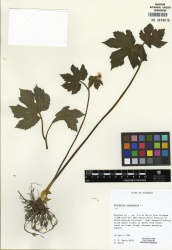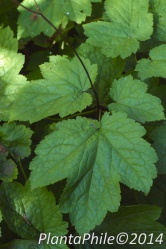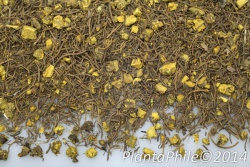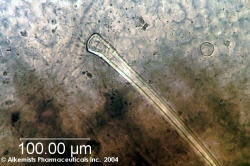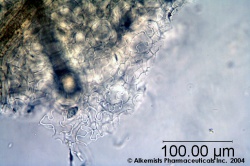Hydrastis canadensis (aerial parts)
From AHPA Botanical Identity References Compendium
(Difference between revisions)
(add askbox) |
(add USD 1918 information (macroscopic)) |
||
| Line 28: | Line 28: | ||
=Macroscopic Characteristics= | =Macroscopic Characteristics= | ||
| + | {| border=1 | ||
| + | | | ||
| + | {{Macroscopy | source=United States Dispensatory (1918) | ||
| + | | description=Hydrastis canadensis is a small, herbaceous, perennial plant, with a thick, fleshy, yellow (rhizome, from which numerous long roots arise, and an erect, simple, pubescent stem, from six inches to a foot in height. There are usually but two leaves, which are unequal, one sessile at the top of the stem, the other attached to the stem, a short distance below by a thick roundish footstalk, causing the stem to appear as if bifurcate near the summit. The leaves are pubescent, roundish-cordate, with from three to seven, but generally five, lobes, which are pointed and unequally serrate. A solitary flower stands upon a peduncle rising from the basis of the upper leaf. It is without corolla, but with a greenish white calyx, the sepals of which closely resemble petals, and are very caducous, falling very soon after the flower has expanded. The fruit is a globose, compound, red or crimson berry, half an inch or more in diameter, composed of many fleshy carpels, each tipped with a short curved beak, and containing one or rarely two seeds. }} | ||
| + | |||
{{Media2 |cat=Macroscopy | {{Media2 |cat=Macroscopy | ||
| source=PlantaPhile | | source=PlantaPhile | ||
| Line 39: | Line 44: | ||
| companyURL2=http://plantaphile.com/ | | companyURL2=http://plantaphile.com/ | ||
| }} | | }} | ||
| + | |} | ||
=Microscopic Characteristics= | =Microscopic Characteristics= | ||
{{Media2 |cat=Microscopy | source=Elan M. Sudberg, Alkemist Laboratories | {{Media2 |cat=Microscopy | source=Elan M. Sudberg, Alkemist Laboratories | ||
Revision as of 02:57, 25 March 2015
Contents |
Nomenclature
Hydrastis canadensis L. Ranunculaceae
Standardized common name (English): goldenseal
Botanical Voucher Specimen
|
|
Organoleptic Characteristics
Macroscopic Characteristics
|
Microscopic Characteristics
 |
 |
|
|
|
High Performance Thin Layer Chromatographic Identification
Supplementary Information
Sources
- ↑ MOBOT, Tropicos.org http://www.tropicos.org/Image/100105541
- ↑ United States Dispensatory (1918)
- ↑ PlantaPhile http://plantaphile.com/
- ↑ PlantaPhile http://plantaphile.com/
- ↑ Elan M. Sudberg, Alkemist Laboratories http://www.alkemist.com
- ↑ Elan M. Sudberg, Alkemist Laboratories http://www.alkemist.com
